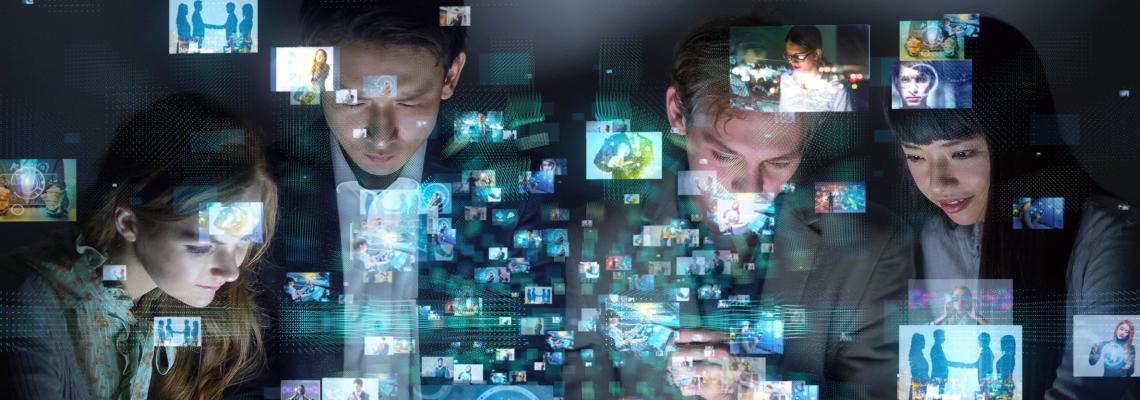1. What are blockchains?
Blockchains are geographically distributed networks of databases that store the same information in a secure, verifiable, and permanent way. Some are hailing them as one of the most revolutionary innovations since the Web – and the potential applications for online learning in higher education are significant. Examples of possible uses range from creating lifelong digital portfolios, storing of academic credentials, and protecting intellectual property through to creating an entire virtual blockchain university. To begin with, here are some descriptions of the concept of blockchains:
- Explainer: What is a Blockchain? – https://www.technologyreview.com/2018/04/23/143477/explainer-what-is-a-blockchain/
- How Does a Blockchain Work? – https://www.youtube.com/watch?v=SSo_EIwHSd4
- 7 Things You Should Know About Blockchain – https://library.educause.edu/resources/2016/9/7-things-you-should-know-about-blockchain
- Understand the Blockchain in Two Minutes – https://blockchainfutureslab.wordpress.com/2016/04/18/understand-the-blockchain-in-twominutes/
- Don Tapscott: The Blockchain Revolution – https://www.youtube.com/watch?v=gZEmaSbqfYQ
2. Why are they relevant to higher education?
Higher education institutions need to be able to track student work, progress toward goals, and credentials earned. Students need to monitor their academic progress, share credentials earned at their previous and current institutions, and keep records of informal learning activities completed and badges accumulated. Academics need to protect ownership of academic property that they create. Blockchains provide the permanence and security to allow institutions, and their students and faculty, to record and share these kinds of data. Here are links to some general discussion papers on the relevancy of blockchains to higher education:
- What is the Role of Blockchain in Education?
- Blockchain in Research and Education – https://www.jisc.ac.uk/reports/blockchain-in-research-and-education
- The Blockchain Revolution and Higher Education – https://er.educause.edu/articles/2017/3/the-blockchain-revolution-and-higher-education
- Will Blockchains Revolutionize Education? https://er.educause.edu/articles/2018/5/will-blockchains-revolutionize-education
- Blockchain in Education – https://ec.europa.eu/jrc/en/publication/eur-scientific-and-technical-research-reports/blockchain-education
- Exploring Blockchain Technology and its Potential Applications for Education – https://link.springer.com/article/10.1186/s40561-017-0050-x
3. Blockchains are not the same as Bitcoins
In 2008, an individual or group of individuals operating under the pseudonym of Satoshi Nakamoto published a white paper that set in motion the crypto-currency called Bitcoin. The underlying technology of the Bitcoin is blockchains, and frequently many incorrectly treat the two concepts as synonymous. In fact, there are three different types of blockchains – public, permissioned, and private. Bitcoin is an example of a public blockchain. Here are links to overviews of the types of blockchains that are available, but note that the actual labels used will vary:
- Difference Between Bitcoin and Blockchain – https://www.youtube.com/watch?v=MKwa-BqnJDg
- Blockchains & Distributed Ledger Technologies
- 3 Popular Types of Blockchains – https://hackernoon.com/3-popular-types-of-blockchains-you-need-to-know-7a5b98ee545a
- What are the Different Types of Blockchain? – https://101blockchains.com/types-of-blockchain/
- Types of Blockchains – https://en.wikipedia.org/wiki/Blockchain#Types_of_blockchains
4. Blockchain-based currencies are being accepted for tuition and services
In 2013, the University of Nicosia in Cyprus announced that it would accept Bitcoin for tuition payment. Since then, a growing number of other institutions are accepting this cryptocurrency for tuition, student expenses, and donations. University of Nicosia even offers a tuition discount when payment is made with Bitcoin. Here are some examples of institutions that accept Bitcoin for tuition and other expenses:
- The King’s College in New York – https://www.tkc.edu/stories/kings-is-first-u-s-college-to-accept-bitcoin/
- Lucerne University of Applied Sciences and Arts in Switzerland – https://www.s-ge.com/en/article/news/20174-crypto-hslu
- European School of Management and Technology in Berlin – https://press.esmt.org/bitcoins
- Simon Fraser University – https://www.theglobeandmail.com/news/british-columbia/simon-fraser-university-embraces-bitcoin-accepts-virtual-currency-for-textbooks/article24610624/
5. Blockchains can support e-portfolios
Blockchains can be used to create a permanent record of one’s formal and informal learning accomplishments – a blockchain e-portfolio. The e-portfolio would be independent of any single academic institution’s computer since blockchains are distributed across networks and there is no central authority. The owner would have full control over the portfolio and could add items as they are earned. They would also have the option to choose to share all or only portions of this e-portfolio with future employers or institutions to which one is applying. Here are links to discussion papers on blockchain-based e-portfolios:
- Reinventing ePortfolio Technology and Practice
- From #ePortfolios to #OpenLedgers via #OpenBadges and #BlockChains – https://www.learningfutures.eu/2015/12/from-eportfolios-to-openledgers-via-openbadges-and-blockchains/
- The Advent of the Personal Ledger – http://badgechain.com/the-advent-of-the-personal-ledger-eportfolios-and-openbadges-unite/
- Digital Portfolios + Open Badges + Blockchain = Personal Learning Ledger – https://wiobyrne.com/digital-portfolios-open-badges-blockchain-personal-learning-ledger/
- The Blockchain and Kudos: A Distributed System for Educational Record, Reputation and Reward – https://link.springer.com/chapter/10.1007/978-3-319-45153-4_48
6. Blockchains can make academic credentials secure
Gathering and sharing of academic credentials is an ongoing aggravation for students as they apply for entrance to post-secondary or graduate education and for employment beyond graduation, especially if they attend multiple institutions. Blockchains can provide secure, trusted, ready access to credentials when needed. Institutions/employers also have the added benefit of knowing that the credentials are genuine, not falsified. Some organizations and institutions are starting to make use of blockchains for this purpose; examples of some are linked to below:
- Holberton School to Authenticate its Academic Certificates with the Bitcoin Blockchain – https://www.globenewswire.com/news-release/2015/10/21/969239/0/en/Holberton-School-to-Authenticate-Its-Academic-Certificates-With-the-Bitcoin-Blockchain.html
- Certificates, Reputation, and the Blockchain – https://medium.com/mit-media-lab/certificates-reputation-and-the-blockchain-aee03622426f
- Blockcerts Introduction – https://www.blockcerts.org/guide/
- Sony Global Education Develops Technology Using Blockchain for Open Sharing of Academic Proficiency and Progress Records – https://www.sony.net/SonyInfo/News/Press/201602/16-0222E/
- Credentials, Reputation, and the Blockchain – https://er.educause.edu/articles/2017/4/credentials-reputation-and-the-blockchain
7. Blockchains can connect students and tutors
Demand for online tutoring in higher education is growing. Moreover, students often face difficulty in identifying knowledgeable, skilled tutors who have successful track records. Blockchains have the potential to address this issue through permanent, secure, and trusted networks. These networks can publish tutors’ skills and ratings by other students, show their availability, and handle direct payment from students to tutors without an intermediary that charges a service fee. Here are links to initiatives that describe how blockchains can accomplish this:
- Uber-U is Already Here – https://teachonline.ca/tools-trends/exploring-future-education/uber-u-already-here
- Blockchain-Based Online Learning Platform to Connect Tutors and Students – https://cointelegraph.com/news/blockchain-based-online-learning-platform-to-connect-tutors-and-students
- Ecosystem for Private Tutoring and Tokenizing Talents – https://ntok.io/docs/en/NTOK%20White%20Paper.pdf
- Want to Learn About Bitcoin and Blockchain? There’s a Tutor for That – https://www.forbes.com/sites/ daviddomzalski/2018/02/22/want-to-learn-about-bitcoinand-blockchain-theres-a-tutor-for-that/#2a27e2e928de
- Learning is Earning 2026 – http://www.learningisearning2026.org/
8. Blockchains can support lifelong learning
When learners transition from higher education to the workplace, they are hindered if they want to keep an accurate, verifiable record of their lifelong learning activities. They may take, for example, informal or formal courses, on-the-job training, MOOCs, or conference workshops. Blockchains offer learners the ability to record these activities in a time-stamped, verifiable way, which they can share with employers or other organizations, even if the credential issuer or host no longer exists. Here are links to how blockchains can be used this way:
- A Learner-Centred Approach for Lifelong Learning Powered by the Blockchain – https://www.researchgate.net/publication/325473333_A_Learner-Centred_Approach_for_Lifelong_Learning_Powered_by_the_Blockchain
- Blockchain Learning: Can Crypto-Currency Methods be Appropriated to Enhance Online Learning? – http://oro.open.ac.uk/44966/8/Devine2015-altc-blockchainlearning-transcript.pdf
- Smart Blockchain Badges for Data Science Education – https://www.researchgate.net/publication/326446367_Smart_Blockchain_Badges_for_Data_Science_Education
- Digital Diploma Debuts at MIT – http://news.mit.edu/2017/mit-debuts-secure-digital-diploma-using-bitcoin-blockchain-technology-1017
- 10 Ways Blockchain Could be Used in Education – https://oeb.global/oeb-insights/10-ways-blockchain-could-be-used-in-education/
9. Blockchains can protect intellectual property ownership
Academics as well as other creators of original intellectual property sometimes face difficulty establishing proof that they were the original creators of those assets. Blockchains offer them the possibility of establishing a timestamped, unalterable, and verifiable record of their creations. If appropriate, blockchains also can collect any royalties or commissions for use of their intellectual property. Here are links that illustrate how blockchains can be used for this purpose:
- The Blockchain and Kudos: A Distributed System for Educational Record, Reputation and Reward – https://link.springer.com/chapter/10.1007/978-3-319-45153-4_48
- Blockai Uses the Blockchain to Help Artists Protect Their Intellectual Property – https://techcrunch.com/2016/03/14/blockai-launch/
- Proof of Existence – https://en.wikipedia.org/wiki/Constructive_proof
- https://en.bitcoin.it/wiki/Proof_of_Ownership
- What is Proof-of-Existence and How Will it Help to Protect Intellectual or Private Property? https://medium.com/@kiknaio/what-is-proof-of-existence-and-how-will-it-help-to-protect-intellectual-or-private-property-77aa97a3fbb1
10. Blockchains have their limitations
Blockchains are far from panaceas for the problems facing online higher education. For one, they are still a relatively new and untested technology that has been hyped by the media (recall the early hype about MOOCs!). A permanent, unalterable record of one’s accomplishments may be problematic if an error was made when the record was originally created. Some individuals may not want a permanent record of their learning outside of their home institution no matter how positive it may be, and the underlying principle of blockchains goes against one’s “right to be forgotten” in the digital world. Links to discussions about limitations such as these are given below:
- Blockchains and Cryptocurrencies: Burn it With Fire – https://www.youtube.com/watch?v=xCHab0dNnj4
- We are at the stage of “irrational exuberance” in evolution of blockchains https://www.gartner.com/smarterwithgartner/the-irrational-exuberance-that-is-blockchain/
- Blockchain and Photography: Proof of Existence Is Not Proof of Ownership – https://www.thephoblographer.com/2018/02/21/proof-existence-not-proof-ownership/
- 7 Things You Should Know About Blockchain [section 5] – https://library.educause.edu/resources/2016/9/7-things-you-should-know-about-blockchain
- Will Blockchains Revolutionize Education? [see Limitations section] https://er.educause.edu/articles/2018/5/will-blockchains-revolutionize-education



